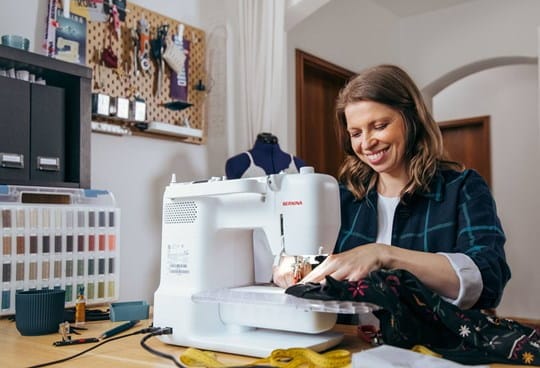Sewing is more than just a practical skill—it’s an art form, a historical necessity, and a creative outlet that has evolved through the ages. From ancient hand stitching to modern computerized machines, the craft of sewing has played a crucial role in shaping cultures, economies, and personal expression. Whether practiced as a hobby or a profession, sewing continues to thrive in the 21st century, adapting to new technologies while preserving traditional techniques.
A Brief History of Sewing
The origins of sewing date back to the Paleolithic era, when early humans used bone needles and sinew to stitch together animal hides for clothing and shelter. These early forms of sewing were essential for survival, particularly in colder climates. As civilizations advanced, so did sewing techniques. Ancient Egyptians used linen thread, and the Chinese developed silk production and embroidery as early as 2,500 BCE.
By the Middle Ages, sewing had become an integral part of domestic life and professional guilds. Tailors and seamstresses were highly regarded, particularly among the nobility. Clothing signified status, and intricate hand-sewn garments were a mark of wealth and power. With the invention of the sewing machine in the 19th century by Elias Howe and Isaac Singer, the industry was revolutionized. Mass production became possible, making clothing more accessible and less labor-intensive.
Types of Sewing
There are many branches within the world of sewing, each with its own techniques, tools, and purposes:
1. Hand Sewing
Hand sewing remains an essential skill despite the rise of machines. It’s ideal for delicate work, repairs, and tasks requiring precision. Techniques like backstitching, hemming, and embroidery all rely on manual craftsmanship. Many sewing enthusiasts find hand sewing to be meditative and fulfilling.
2. Machine Sewing
Sewing machines offer speed and consistency, making them indispensable for modern sewing. They are used in home settings and industrial environments alike. Machines can handle a variety of fabrics and stitches, from straight and zigzag patterns to buttonholes and overlocking.
3. Embroidery
Embroidery is the decorative aspect of sewing, involving intricate patterns stitched into fabric. This art form varies widely across cultures—think of Indian zari work, Japanese sashiko, or European cross-stitch. Embroidery can be done by hand or with specialized machines.
4. Quilting
Quilting combines layers of fabric sewn together, often with padding, to create items like blankets or jackets. It involves both functional and artistic elements, with patterns ranging from simple blocks to complex geometric designs.
5. Tailoring
Tailoring refers to the creation or alteration of garments to fit specific body measurements. It requires deep knowledge of fabrics, body shapes, and sewing techniques. Tailors play a key role in the fashion industry and personal wardrobe design.
Essential Tools for Sewing
Whether you’re a beginner or an experienced sewer, having the right tools is crucial. Here are some of the most common:
- Needles: Available in various sizes and shapes for different fabrics and purposes.
- Thread: Comes in cotton, polyester, silk, and other blends; color and thickness should match the project.
- Scissors: Sharp fabric scissors are essential; avoid using them on anything else to maintain their edge.
- Measuring tape: For accurate sizing and fitting.
- Pins and pincushion: Used to hold fabric pieces together before sewing.
- Seam ripper: A small tool for removing stitches—essential for correcting mistakes.
- Sewing machine: Varies from basic models to computerized versions with advanced functions.
Choosing Fabrics
Fabric selection can make or break a sewing project. Fabrics differ in stretch, weight, texture, and drape, all of which affect how they handle and how the finished product looks. Common fabric types include:
- Cotton: Versatile, breathable, and easy to sew—ideal for beginners.
- Silk: Luxurious but slippery; requires experience.
- Wool: Warm and often used for suits and coats.
- Linen: Light and airy but wrinkles easily.
- Synthetic fabrics: Polyester and nylon are durable and often less expensive.
Understanding fabric behavior through trial, error, and practice is part of mastering the craft of sewing.
Why People Sew
People sew for many reasons, and motivations can vary by culture, age, and lifestyle.
1. Creativity and Self-Expression
Sewing allows people to bring their ideas to life—whether it’s a custom outfit, a home decor project, or a unique bag. Colors, patterns, and textures combine to reflect a person’s individual style.
2. Sustainability
With growing awareness of fast fashion’s environmental impact, many individuals turn to sewing to reduce waste. Making or mending clothes extends their life and minimizes landfill contributions.
3. Cost Efficiency
While the initial investment in tools and machines can be high, sewing can save money in the long run. Tailoring clothes, making gifts, or repurposing old fabrics becomes more economical than buying new.
4. Therapy and Relaxation
Sewing is known for its calming effects. Focusing on a repetitive task like stitching can reduce anxiety and promote mindfulness. Many people find peace and satisfaction in the process.
5. Professional Opportunities
Sewing can be a gateway to entrepreneurship. From small Etsy shops to full-fledged fashion labels, skilled sewers can build careers in tailoring, costume design, fashion, and upholstery.
Modern Developments in Sewing
While traditional sewing remains strong, the craft has embraced modern innovations:
- Computerized Machines: High-tech sewing machines can store patterns, auto-cut threads, and even offer on-screen tutorials.
- Online Communities: Platforms like YouTube, Reddit, and sewing forums allow people to learn, share patterns, and troubleshoot issues.
- Sewing Apps and Software: Tools like pattern-making software help users design custom garments.
- Sustainability Movements: Zero-waste patterns, upcycling, and eco-friendly fabric choices are becoming mainstream.
Challenges Faced by Beginners
While sewing can be incredibly rewarding, beginners often face challenges such as:
- Learning Curve: Understanding machines, reading patterns, and handling fabrics takes time.
- Mistakes: Errors are common—seams may pucker, thread might snap, or garments may not fit as expected.
- Time Investment: Sewing requires patience; rushing through projects can lead to poor results.
- Cost of Materials: Quality tools and fabrics can be pricey, which may deter some newcomers.
These obstacles are part of the learning journey. With practice and perseverance, they become valuable lessons.
Tips for Sewing Beginners
- Start Small: Begin with simple projects like tote bags or pillowcases to build confidence.
- Take a Class: Community centers, craft stores, and online platforms offer lessons.
- Invest in Quality Tools: A reliable machine and good scissors can make a big difference.
- Practice Reading Patterns: Commercial patterns often include detailed instructions and measurements.
- Keep a Sewing Journal: Documenting your projects, challenges, and successes can be motivating and helpful for growth.
The Cultural Impact of Sewing
Sewing is deeply embedded in cultural traditions worldwide. In Africa, wax print fabrics are used for ceremonial attire, with sewing often a rite of passage. In Japan, the meticulous techniques of sashiko and kimono construction reflect centuries of craftsmanship. In the West, quilting bees were once social events where women bonded while creating heirlooms.
These traditions preserve history and heritage. By learning to sew, individuals often connect with their ancestors and keep cultural practices alive.
Conclusion: The Endless Thread of Sewing
Sewing is a skill that combines practicality, beauty, and emotional satisfaction. Whether you’re patching up old jeans or designing a couture gown, sewing empowers you to create something tangible with your hands. It promotes patience, problem-solving, and self-reliance. In a world increasingly dominated by automation and convenience, sewing reminds us of the value of time, craftsmanship, and personal expression.
In many ways, sewing is more relevant than ever. It bridges the past and the future, tradition and innovation. For those willing to thread the needle, the possibilities are endless.




